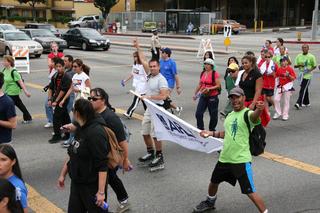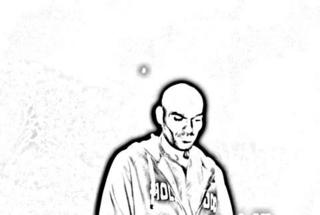Ampula
A blog on channeling my energies to achieve more balance, introspection, progessive living & transgressing.........
Monday, October 31, 2005
Is 'white' the only color of success?
Hi Ampulites! Back from Toronto.
Today, a rare 'in the news' piece on how the Ethnicity/Culture of professionals affects their rate of promotions.
Is 'white' the only color of success?Minorities can have their careers derailed by their tone of voice or hairstyle, a new study shows.
By Marilyn Gardner Staff writer of The Christian Science Monitor
During her years as an attorney for one of the top international law firms in the United States, Angela Williams looked forward to defending clients. But sometimes she was not given the chance.
"When it came time for an opportunity to represent Fortune 500 companies on huge cases, even though I might have had trial experience over and above my white male colleagues, they were chosen," says Ms. Williams, who is African-American.
In an age of diversity, when many companies point with pride to their multicultural workforce, a sobering reality remains: Minority professionals often find their career ambitions thwarted by hidden bias - what workplace experts call the new face of discrimination. "Acting white," they say, can be the price of promotion in a business world where white men account for 98 percent of CEOs and 95 percent of top earners in Fortune 500 companies. Diversity does not always extend to the executive suite.
"Minorities are getting stuck in the early stretches of career structures," says economist Sylvia Ann Hewlett, whose study of minority professionals appears in the November Harvard Business Review. "They are not getting promoted and advanced at a rate commensurate with their weight in the talent pool."
In a survey of more than 1,600 minority professionals, Dr. Hewlett and Princeton professor Cornel West found that sterling credentials can be overshadowed by personal and cultural traits. Everything from cornrows, ethnic jewelry, animated hand gestures, and certain manicures can leave colleagues thinking, "You're different."
Forty years ago, it was very easy to see prejudice, Hewlett notes. "People wore it on their sleeve and enshrined it in law. Today, it's much more subtle, but it's pervasive. Whether it's a tone of voice or hairstyle or accent, the cumulative impact can be brutal and can derail a career."
The study comes just weeks after Neil French, the creative director of WPP Group, reportedly explained the small ranks of female advertising directors by saying that "they don't deserve to make it to the top" because of their family obligations. He resigned over the flap.
While the proverbial glass ceiling remains one obstacle for women and minorities, Hewlett identifies another barrier - a "Jell-O floor" that keeps them mired in negative stereotypes.
Over 40 percent of minority professional women in large corporations say they feel excluded and constrained by "style compliance" - the need to blend into a corporate culture dominated by white men. More than a third of minority men feel the same way.
"The pressure is added for minority professionals because we don't necessarily come from the same background as those in leadership positions, and we haven't had the same experiences," says Williams, a vice president of Sears in Chicago.
A quarter of minority businesswomen worry that they are perceived as "affirmative action" hires. In addition, nearly a third of minority female executives are concerned that their speaking style labels them as lacking leadership potential.
"Asian women executives were convinced that they weren't commanding enough in their tone of voice, and were not assertive," says Hewlett. "African-American managers were quite sure they spoke too loudly, were too threatening."
One woman, a native of India who works as an IT executive at a Fortune 500 company, learned that colleagues regarded her as quiet. "There are people who talk just to be talking," says the woman, who asks not to be identified to protect her job. "That's not my style. People said, 'She's quiet.' Management perceived that I didn't have leadership quality. Eventually people said, 'But when she says something, it's valuable.' The last few years, I haven't heard them talk about this 'quiet' thing."
Both whites and minorities must adapt, she says. "People like me coming to Western society and working here have to figure out that there are certain things you have to do, that you have to project certain things. That becomes part of the norm of being a successful professional leader."
Referring to Americans' views of professionals from India, she says, "There's a stereotype that they're very good technically, you can rely on them, but they're not really the leaders of tomorrow." Yet she is encouraged by changes at her firm. "They're looking for diversity candidates like me who can grow."
Invisibility - not being heard or seen - remains an issue for women of color, says Ella Bell, an associate professor of business at Dartmouth. "If a woman of color speaks up to make her point, it will just plop. A white male will pick it up and all of a sudden it's bells and whistles." White women might have similar experiences, she adds, but not to the same degree.
Professor Bell also notes a reverse challenge: "You become visible when they need an affirmative action poster child to show that they're making a good attempt to connect to minority communities. That kind of visibility doesn't contribute to the bottom line, so it doesn't help when it comes to promotions."
Another form of invisibility occurs outside the office. To a much greater degree than their white peers, minority professionals spend off-hours doing charitable work. One-quarter are religious leaders. Nearly 30 percent are mentors to needy young people. Forty percent engage in a variety of social outreach activities. Yet many remain silent at work about this service.
"The work they do in minority communities, which is leadership, is very important, but their corporate managers never know about it," Bell says. "It doesn't get counted. Meanwhile, John Doe, who happens to be Caucasian, is on the United Way board or the arts council. It's a big deal."
Hewlett tells of a young woman who formed Girl Scout troops at homeless shelters in Washington, D.C. She received an award at the White House for her work but had not told her boss about it.
"She was afraid to," Hewlett says. "She thought it would imply that a homeless shelter was the kind of background she came from, and she didn't want to be stuck with that label."
Being open about outside activities can bring rewards. When Sears hired Williams as chief compliance and ethics officer, she was told that part of the reason she was hired was because she was both a successful lawyer and an ordained Baptist minister. "The general counsel said to me, 'Who better to be the conscience of the company than a lawyer and a minister in one person?' If people really felt free to let corporate America know the things they are involved with outside their 9-to-5 jobs, that can be an enhancement to their performance on the job."
Williams, who counts fewer than five minority CEOs of Fortune 500 companies, sees progress. But, she adds, "We still have a long way to go."
Eral Burks, CEO of Minority Executive Search in Cleveland, also finds bias camouflaged.
"Companies talk about bringing on more minority board members and senior executive staff, but they're always finding excuses why they won't hire a prospective candidate," he says. "They weren't really interested in hiring, but it looks good that they brought people in. A lot of companies don't think there are qualified minority candidates."
Some firms are designing strategies to combat hidden bias. These include benefits that serve extended families.
Pointing out that minorities have spending power, Mr. Burks says, "They're going to be buying your product or service. They're starting to look at companies and say, 'Why should we spend our money here if your senior staff looks a totally different color?' "
Some CEOs, he adds, "are becoming aware that it makes good business sense to get senior-level staff on their team. They're very positive about wanting to hire more executive minorities and women candidates."
More from the authors of the study:
Not our kind of people, 2005
By Sylvia Ann Hewlett and Cornel West October 30, 2005
TIME WAS, prejudice was easy to recognize: The back of the bus. No Irish need apply. Not our kind of people, dear. People put their bias right out there, enshrining it in law and scribbling it on signs in shop windows for all the world to see.
Today, prejudice is different, more subtle. But it's still brutal. And just as in yesteryear, it still works as a weapon wielded by those in power and with privilege to keep others without, and out of places lots of us would like to be -- the corner offices of corporate America, for example. Skeptics looking for the persistence of prejudice need look no further than the Fortune 500, where 98 percent of CEOs and 95 percent of top earners are men, the overwhelming majority of them white. Our new study, published in the November issue of the Harvard Business Review, explains why.
Consider Penny Knoll. A platinum-grade talent with a Columbia MBA, labeled a ''high performer" in the early stretches of her career at a Fortune 500 company, Penny hit a wall in middle management. Senior colleagues professed themselves uncomfortable with her style, her gesticulating, her cornrows, her loud laughter. She tried to tone herself down and failed, and the years passed, and the stress of not getting promoted despite a stellar track record began to tell. She lowered her sights and disengaged. In her words: ''I quit, but stayed on the job."
She is not alone. Thousands of minority professionals have fallen victim to subtle forms of hidden bias in the large corporations that are in so many other ways the pride of our economy. Our new research, which features a nationally representative survey of 1,201 minority US managers, demonstrates how psychological hazards like ''style compliance" bar minorities from the executive suite.
Key findings:
42 percent of minority professional women in large corporations feel constrained by the white male model -- constantly editing themselves, engaged in the hopeless task of trying to look, sound, and act like white male executives. Thirty-four percent of minority men feel the same way.
Nearly a third of minority female executives fear that their speaking style and tone of voice label them as lacking leadership potential. Asians think they speak too softly to be considered CEO material; African-Americans think that they speak too loudly and are therefore seen as trouble-makers.
23 percent of minority female executives are concerned that their animated hand gestures are thought of as inappropriate. ''You can't imagine how often I sit on my hands at team meetings," said one Hispanic woman we interviewed.
19 percent of minority female professionals worry that their clothing (hairstyle or even manicure) stands out as being too ethnic or flamboyant. In the words of one African-American executive, ''Large earrings, the wrong nails -- stuff that wouldn't begin to attract attention on a white colleague -- makes me stand out like a sore thumb."
30 percent of minority professionals feel that promotion in their companies is based on appearance rather than merit.
The bottom line: 19 percent of minority professionals experience hidden biases severe enough to make them consider quitting. This is a wake-up call for companies. Since minorities comprise 30 percent of the highly qualified talent pool, hidden bias is a luxury few employers can afford.
Which is why we are seeing new action on this front. Leading-edge companies are beginning to design strategies that actively combat these forms of discrimination. Ernst & Young, Cisco, and American Express, for example, have mounted employee workshops that encourage participants to bring subtle biases to the surface -- where they can be deconstructed and dealt with. Other companies have uprooted hidden bias from their own policies. Time Warner and Johnson & Johnson realized that their benefit packages were excluding minority families that don't fit the traditional nuclear model and extended benefits accordingly. At Booz Allen, General Electric, Goldman Sachs, and Lehman Brothers, corporate leadership has invested heavily in affinity networks that provide minority employees with safe harbors while they grapple with hidden bias.
Tackling hidden bias is a daunting challenge. As Harvard psychologist Mahzarin Banaji demonstrates with her diagnostic instrument, the Implicit Association Test, even the most well intentioned person is constantly stereotyping those with whom she/he interacts. But this is a challenge that employers have to take on if they are to survive and thrive in a global, multiracial world where ''talent" is increasingly nonwhite. A ''not our kind of people, dear" attitude is profoundly wrong, but it also happens to be hugely inefficient in 2005.
Sylvia Ann Hewlett is president of the Center for Work Life Policy in New York and heads the Gender and Policy Program at Columbia University's School of International and Public Affairs. Cornel West is a professor of religion at Princeton University.
Thursday, October 20, 2005
Monday, October 17, 2005
Wednesday, October 12, 2005
Pics fro Catalina Island

Hiking trip to Catalina Island this weekned; quite fun! Here are a few pics; Njoy!
Santa Catalina Island, often called simply Catalina Island, is a rocky island off the coast of California.
The 76 mi²/48,000 acre (194 km²) island is located about 22 miles (35 km) south-southwest of San Pedro, Los Angeles, California and is part of Los Angeles County.
It is the only one of the Channel Islands chain to have a permanent civilian settlement and urbanization; most of the 3,000 residents live in the resort city of Avalon, California. Most of the island is owned by the Catalina Island Conservancy.
Monday, October 03, 2005
SLUTS, WHORES, HOS.....
An individual who takes pleasure in sex & sexuality. That means to fuck as is her/his wont and without guilt or remorse; when the sun comes up, her/his body is still her own. These individuals wield a profound power because they are in full possession of their own sexuality.
from Mistress Ruby Ties It Together
By Robin Shamburg
Scenario(s):
§ Max went out to have a fun night with friends. Max danced, flirted and made out with a number of girls. He got lucky with 2, although he only took 1 home, giving the other a rain-check. This would bring Max’s monthly sex total to 5, & it was only the 10th of the month.
§ Melanie hung out with her girlfriends & told them she wanted to hook-up with a cutie. They were attending a party thrown by her co-worker’s boyfriend, who is a DJ. Melanie had all kinds of attention and offers but chose to take 1 guy home after she confirmed with her friends that the girl he was with was NOT interested in him. With this, Melanie carved notch 8 into her headboard in this already young year.
Once someone has granted a person the title ‘slut’, it sticks. If someone is coy about sexuality or does not have much sexual experience, but has a string of known sexual experiences, they may be called a slut, by judgmental onlookers. However, once they become monogamous or becomes less sexually active, they will likely retain their status as ‘slut’. Like an annoying relative, ‘sluthood’ is easy to get, but difficult to get rid of. If a woman or man desires sex and actively pursues it, their behavior is not viewed as sexually self-determined, but oftentimes pathologized or viewed as a personal problem.
Discourse on desire and sexuality in the United States is in an infantile state. There is a fear of owning up to one’s sexual desires, fear of what attempting to achieve them might bring and a fear of harsh judgment form society. The thought of a sexually liberated heterosexual woman creates fear within heterosexual men. The het man may be bombarded by insecurities which beg him to ask: Will she be more sexually experienced than he? Will she be too demanding in bed? Will I not be in control of our sex lives? Will she fool around on me if I don’t please her in bed? The thought of a ‘sexually liberated’ het male is usually taken for granted, het men are expected to have had a number of sexual experiences and expected to flaunt their prowess among their peers as a means to exemplify their maleness. The challenge to this type of society is to redefine gendered meanings around sexuality, desire and sexual experience. This would lead to women who feel free to express their erotic (both in & beyond) needs & desires and have an expectation that their het male partners will try & meet them. The power dynamic would be forever changed, leaving het men to be expected to respect women and not hang their maleness on such superfluous nails as ‘gender’.
With the current state of het sexuality being such, one would think queers offer a more liberatory view of sexuality. Sure the sexual energy of queer men (in general) is pretty high & ambitious and there are fewer judgments, but they still view sex through a gendered lens. For example, if someone receives the penis (oral/anal) they are considered the ‘bottom’, receptive and therefore feminized; if someone enters the orifice (oral/anal) they are considered the ‘top’ or insertive partner and therefore ‘masculinized’. Aggressiveness is attributed to maleness and passiveness is attributed to femaleness. In actual sexual interactions (amongst queers & hets), there is usually some combination of passiveness & aggressiveness. Indeed, role reversal, or acting out sexually contrary to how one ‘presents’ has the power to create powerful sexual chemistry.
In the end one should explore what they like about sex (if anything), an not be afraid to openness to further exploration with different partners, while not compromising what they need to be fulfilled.
When I think of the word whore, I think of English drawing room comedies and 18th century literature where some doomed heroine is condemned to death for some past indiscretion. Let’s get one thing straight, I am not a whore.
You can call me a Ho. I like the word Ho because it calls to mind the Black exploitation pictures of the seventies. Yes, I see myself as a male Pam Grier-all afro, flashy polyester and by-the-balls attitude. I think seventies icon Pam Grier might have been called a Ho in all of her films right before kicking the culprits butt. So, call me a Ho as long as I get to kick your butt after you’re done.
My detractors just say slut. The only thing is slut seems dirty. I don’t know why but say the two words: Ho and Slut. There is something strong and forceful about the word Ho while slut sounds steeped in grime and dirt of hesitation. Years ago, one of my friends (He was definitely a Ho) taught me the difference between a slut and a Ho. One gets paid and the other doesn’t get paid for their sexual endeavors; however, I’ve broadened the definition to someone who loves one thing so much he or she doesn’t mind getting paid for doing it. Funny, I can never remember which went with his original definition. I know my friend always said he was going to be the best Ho he could be. Co-opting that old armed forces tag seemed something a good Ho would do. It doesn’t hurt that at various times I have been called all of the above and a few other names, I won’t go into at this time. Yet, the only one time the words had any sting was when the word slut was used and even then, I was left wondering what’s so bad about it.
Let’s face it all these words stems from someone’s desire to classify that which they don’t really know. Before the feminist movement and the emergence of a new genre of women’s writers of the later twentieth century, most male (and many female) authors painted their female characters as either madonnas or whores. Wives who had affairs were whores. Wives who suffered silently were madonnas. Virgins were madonnas until they lost their virginity and if it wasn’t their wedding night they became whores. There was no middle ground-you were either good or bad.
Now, we do it a bit differently. We seldom speak of whores unless you’re writing a Woody Allen/Gary Marshall Movie and searching for another way to write the proverbial misguided girl with the heart of gold. Too bad, these sugar coated paper dolls would never be considered a Ho or even a slut in my book. Hell, they aren’t even whores but some middle aged man’s fantasy of what prostitution is all about. I won’t dare tackle that issue here. Let’s move on to the world of rap. Rappers really don’t sing about whores or even sluts. It’s the Ho who gets immortalized (for lack of a better word) by the folks with the mike. Yeah, almost every rapper rhymes about his present girlfriend in glowing terms-she could never be any of the above. Let the relationship end and she moves to Ho status. Have we just relabeled that old Woody Allen/Gary Marshall Movie in gangsta attire and called it a day?
So, what does it all mean? Not a damn thing, the reality of the situation is if you are truly what you are. So own it, be it and don’t let anyone label you anything that you’re not or not afraid to call yourself.
-Jim "HO"









